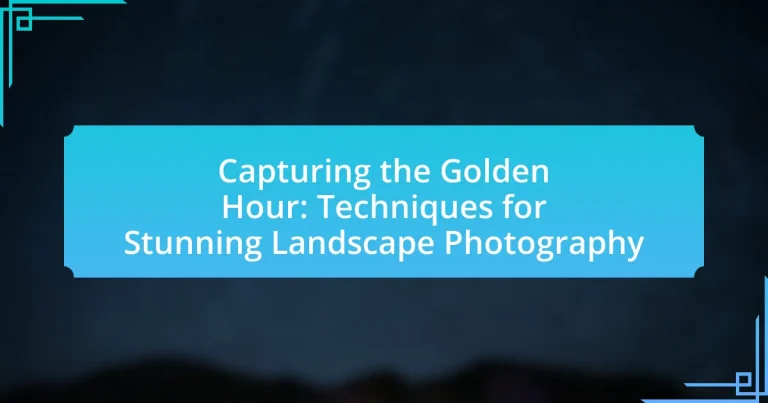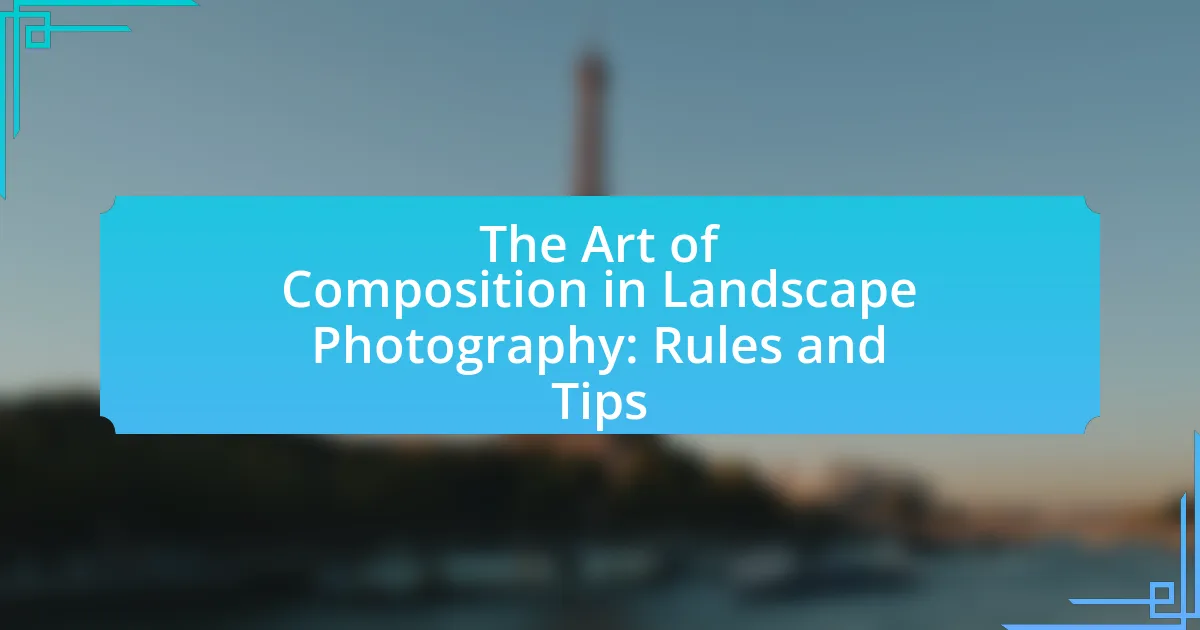The article focuses on the Golden Hour in landscape photography, a crucial period shortly after sunrise and before sunset characterized by soft, warm, and diffused natural light. It highlights the importance of this phenomenon for photographers, detailing how the unique lighting conditions enhance colors and shadows, making landscapes more visually appealing. Key techniques for capturing stunning images during this time are discussed, including optimal camera settings, composition strategies, and essential equipment. Additionally, the article addresses challenges photographers may face, such as changing weather conditions and crowds, while providing practical tips for preparation and post-processing to maintain the natural beauty of Golden Hour images.
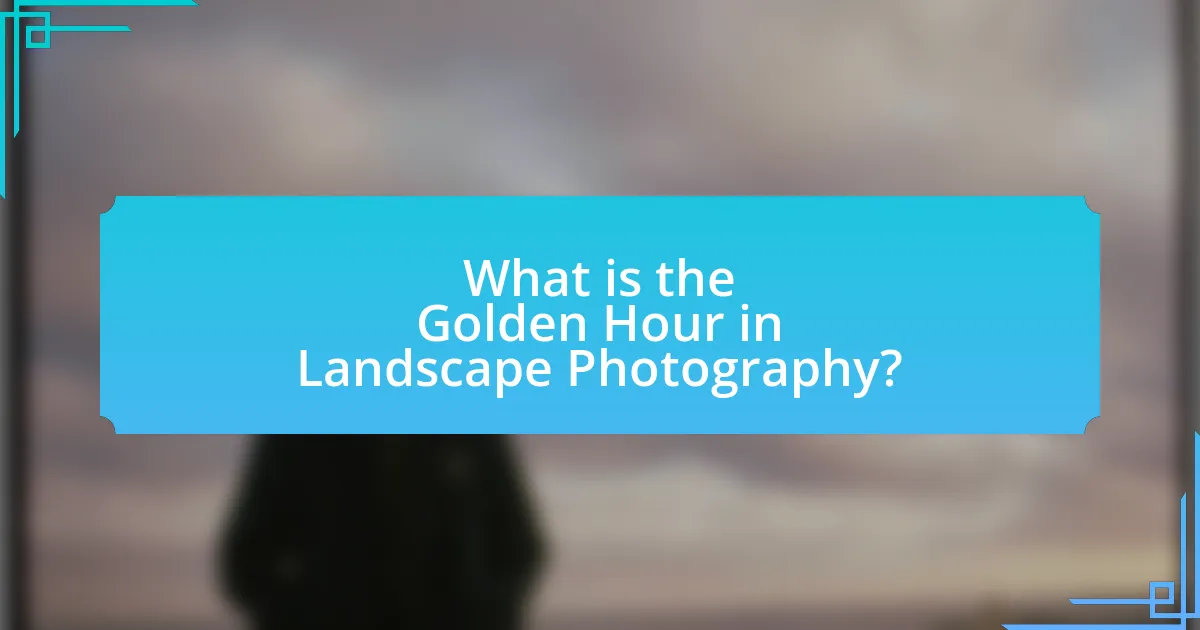
What is the Golden Hour in Landscape Photography?
The Golden Hour in landscape photography refers to the period shortly after sunrise and before sunset when the natural light is soft, warm, and diffused. During this time, the sun is low in the sky, creating long shadows and enhancing colors, which results in visually appealing images. This phenomenon is scientifically supported by the angle of sunlight, which reduces harsh contrasts and highlights textures in the landscape, making it an optimal time for photographers to capture stunning visuals.
Why is the Golden Hour important for photographers?
The Golden Hour is important for photographers because it provides soft, diffused lighting that enhances the quality of images. During this time, which occurs shortly after sunrise and before sunset, the sun is low in the sky, resulting in warm tones and long shadows that add depth and dimension to photographs. This unique lighting condition can significantly improve the aesthetic appeal of landscape images, making colors appear more vibrant and textures more pronounced. Studies in photography emphasize that images taken during the Golden Hour often evoke a sense of warmth and tranquility, which can lead to higher viewer engagement and emotional response.
What unique lighting conditions occur during the Golden Hour?
During the Golden Hour, unique lighting conditions include soft, diffused sunlight that creates warm tones and long shadows. This occurs because the sun is low on the horizon, resulting in light that passes through more of the Earth’s atmosphere, scattering shorter blue wavelengths and allowing longer red and orange wavelengths to dominate. This phenomenon enhances the colors in landscapes, making them appear more vibrant and visually appealing, which is why photographers often seek this time for capturing stunning images.
How does the Golden Hour affect colors and shadows in landscapes?
The Golden Hour enhances colors and shadows in landscapes by producing warm, soft light that intensifies hues and creates long, dramatic shadows. During this period, which occurs shortly after sunrise and before sunset, the sunlight has a lower angle, resulting in a golden tint that enriches the saturation of colors, making greens appear more vibrant and blues deeper. Additionally, the elongated shadows cast by this low-angle light add depth and dimension to the landscape, emphasizing textures and contours. Studies in photography highlight that this unique lighting condition can significantly improve the aesthetic quality of images, making them more visually appealing.
When does the Golden Hour occur?
The Golden Hour occurs shortly after sunrise and just before sunset. During these times, the sunlight is softer and warmer, creating ideal conditions for photography. This phenomenon is due to the angle of the sun, which results in longer shadows and a more diffused light, enhancing the visual appeal of landscapes.
What factors influence the timing of the Golden Hour?
The timing of the Golden Hour is influenced primarily by the position of the sun in relation to the horizon, which varies based on geographic location, time of year, and atmospheric conditions. Geographic location affects the angle and duration of sunlight, with higher latitudes experiencing longer Golden Hours during summer months. The time of year also plays a crucial role, as the sun rises and sets at different times throughout the seasons, altering the duration of the Golden Hour. Additionally, atmospheric conditions such as cloud cover and pollution can affect the quality and intensity of light during this period, impacting the overall experience of the Golden Hour.
How can photographers determine the Golden Hour for their location?
Photographers can determine the Golden Hour for their location by using tools such as smartphone apps or websites that calculate sunrise and sunset times based on geographic coordinates. These tools provide precise timings for the Golden Hour, which occurs approximately one hour after sunrise and one hour before sunset, creating optimal lighting conditions for photography. For example, the app “Golden Hour” or websites like Timeanddate.com can give accurate local times for these periods, allowing photographers to plan their shoots effectively.
What are the key techniques for capturing stunning landscape photos during the Golden Hour?
The key techniques for capturing stunning landscape photos during the Golden Hour include using a tripod for stability, adjusting the camera settings for optimal exposure, and composing the shot to include foreground interest. A tripod minimizes camera shake, especially in low light conditions typical of the Golden Hour. Adjusting settings such as aperture and ISO allows photographers to capture the rich colors and dynamic range present during this time. Composing the shot with elements in the foreground enhances depth and draws the viewer’s eye into the scene, making the photograph more engaging. These techniques are widely recognized among professional photographers for their effectiveness in landscape photography during the Golden Hour.
How can composition enhance Golden Hour photography?
Composition enhances Golden Hour photography by strategically arranging elements within the frame to maximize the impact of the warm, soft light. Effective composition techniques, such as the rule of thirds, leading lines, and framing, draw the viewer’s eye to the subject while utilizing the unique lighting conditions of the Golden Hour. For instance, placing the horizon line along the lower third of the frame can emphasize the vibrant sky, which is particularly striking during this time. Additionally, incorporating foreground elements can create depth and context, making the scene more engaging. Studies in photography emphasize that well-composed images taken during the Golden Hour can evoke stronger emotional responses due to the interplay of light and shadow, enhancing the overall aesthetic appeal.
What camera settings are optimal for Golden Hour shots?
Optimal camera settings for Golden Hour shots include using a low ISO (100-400), a wide aperture (f/2.8 to f/5.6), and a shutter speed that balances exposure, typically between 1/60 to 1/250 seconds. These settings enhance the warm, soft light characteristic of Golden Hour, allowing for rich colors and reduced noise. The low ISO minimizes grain, while a wide aperture creates a shallow depth of field, isolating subjects beautifully. Adjusting the shutter speed ensures proper exposure without overexposing highlights, which is crucial during this time when light changes rapidly.
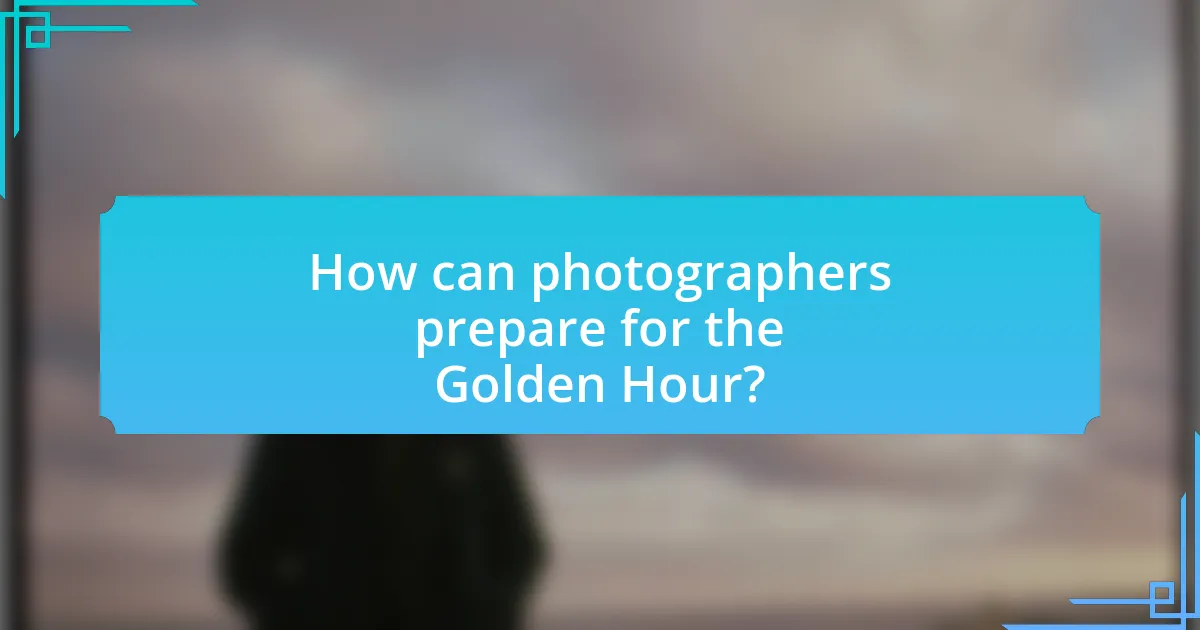
How can photographers prepare for the Golden Hour?
Photographers can prepare for the Golden Hour by planning their shoot location and time in advance. This involves using tools like weather apps and sunset calculators to determine the exact timing of the Golden Hour, which occurs shortly after sunrise and before sunset. Additionally, photographers should scout the location beforehand to identify the best angles and compositions that will take advantage of the warm, soft light characteristic of this time. Research indicates that the quality of light during the Golden Hour enhances colors and textures, making landscapes appear more vibrant and appealing.
What equipment is essential for Golden Hour photography?
Essential equipment for Golden Hour photography includes a DSLR or mirrorless camera, a tripod, and a wide-angle lens. A DSLR or mirrorless camera allows for manual settings adjustments, which are crucial for capturing the dynamic lighting conditions during Golden Hour. A tripod stabilizes the camera for longer exposure times, reducing motion blur in low light. A wide-angle lens enables photographers to capture expansive landscapes, maximizing the effect of the warm, golden light. These tools collectively enhance the ability to create stunning images during this unique time of day.
How do different lenses impact Golden Hour images?
Different lenses significantly impact Golden Hour images by altering the perspective, depth of field, and light capture. Wide-angle lenses, for instance, enhance the expansive feel of landscapes, allowing more of the scene to be included, which is particularly effective during Golden Hour when the light is soft and colors are vibrant. Conversely, telephoto lenses compress the scene, isolating subjects and creating a more intimate portrayal of distant elements, which can highlight the warm hues of the setting sun against the landscape. Additionally, prime lenses often provide superior sharpness and wider apertures, enabling better low-light performance during this time, thus capturing the rich details and textures that Golden Hour offers. The choice of lens directly influences the composition and emotional impact of the photograph, making it essential for photographers to select the appropriate lens based on their desired outcome.
What accessories can enhance the shooting experience during the Golden Hour?
Tripods, filters, and remote shutter releases are essential accessories that can enhance the shooting experience during the Golden Hour. Tripods provide stability for long exposure shots, allowing photographers to capture the soft light and vibrant colors without camera shake. Filters, such as polarizing or neutral density filters, help manage reflections and control light intensity, enhancing the overall image quality. Remote shutter releases prevent camera movement when taking photos, ensuring sharp images during low-light conditions. These accessories collectively improve the ability to capture stunning landscape photographs during this optimal lighting period.
How can photographers scout locations for Golden Hour shots?
Photographers can scout locations for Golden Hour shots by utilizing tools like photography apps, maps, and local knowledge to identify optimal vantage points. These tools help photographers determine the sun’s position and the landscape’s features during the Golden Hour, which occurs shortly after sunrise and before sunset. For instance, apps like Sun Seeker or The Photographer’s Ephemeris provide real-time data on sunlight angles and times, allowing photographers to plan their shoots effectively. Additionally, visiting potential locations at different times of the day can help photographers understand how light interacts with the environment, ensuring they capture the best possible images during this critical time.
What tools can assist in finding the best locations for Golden Hour photography?
Tools that assist in finding the best locations for Golden Hour photography include smartphone applications like Golden Hour, Sun Surveyor, and The Photographer’s Ephemeris. These applications provide precise data on sunrise and sunset times, as well as the angle of sunlight, which is crucial for capturing optimal lighting conditions. For example, The Photographer’s Ephemeris allows users to visualize the sun’s path at any location and time, helping photographers plan their shoots effectively. Additionally, websites like PhotoPills offer similar functionalities, enabling users to determine the best spots for Golden Hour based on geographic coordinates.
How does understanding the landscape help in planning for the Golden Hour?
Understanding the landscape is crucial for planning for the Golden Hour because it allows photographers to anticipate how natural light interacts with various elements in the environment. Knowledge of the terrain, including hills, valleys, and bodies of water, helps in determining the optimal angles and positions for capturing light as it changes during this time. For instance, landscapes with prominent features can create dramatic shadows and highlights, enhancing the visual impact of photographs. Additionally, understanding the local weather patterns can inform photographers about potential cloud cover or atmospheric conditions that may affect light quality during the Golden Hour. This strategic awareness ultimately leads to more compelling and aesthetically pleasing images.
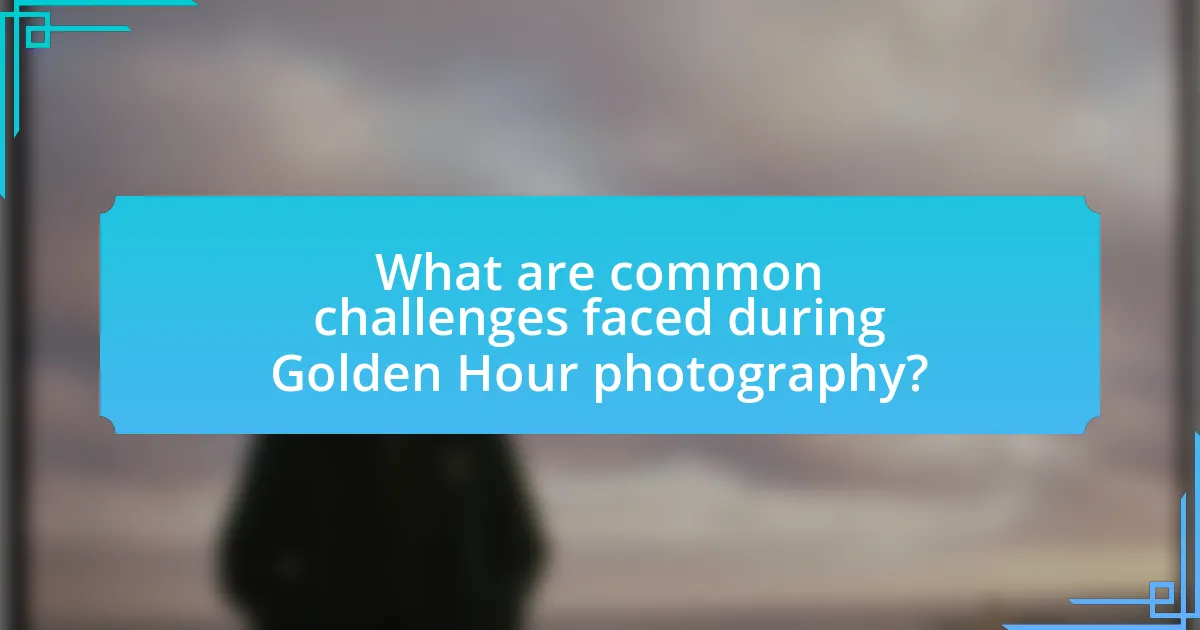
What are common challenges faced during Golden Hour photography?
Common challenges faced during Golden Hour photography include rapidly changing light conditions, difficulty in achieving proper exposure, and managing shadows. The light during Golden Hour is often soft and warm, but it can shift quickly, making it challenging for photographers to adjust settings in time. Additionally, the low angle of the sun can create harsh shadows that may obscure details in the landscape, complicating composition. Photographers must also contend with the potential for overexposure in highlights, as the contrast between light and dark areas can be significant during this time.
How can changing weather conditions affect Golden Hour photography?
Changing weather conditions can significantly impact Golden Hour photography by altering light quality, color temperature, and atmospheric effects. For instance, overcast skies can diffuse sunlight, resulting in softer, more even lighting that reduces harsh shadows, while clear skies can produce vibrant colors and dramatic contrasts. Additionally, weather phenomena such as fog or rain can create unique atmospheric effects, enhancing the mood and depth of photographs. Studies show that the presence of clouds during Golden Hour can lead to more dynamic and colorful sunsets, as they reflect and scatter light effectively. Therefore, photographers must adapt their techniques based on the prevailing weather to optimize their Golden Hour captures.
What strategies can photographers use to adapt to unexpected weather changes?
Photographers can adapt to unexpected weather changes by utilizing flexible planning, appropriate gear, and creative techniques. Flexible planning involves monitoring weather forecasts and being prepared to change locations or schedules based on real-time conditions. Appropriate gear includes waterproof covers for cameras and lenses, as well as protective clothing for the photographer, which ensures equipment safety and personal comfort. Creative techniques, such as using dramatic cloud formations or rain to enhance the mood of a photograph, can turn adverse weather into an opportunity for unique shots. These strategies are supported by the fact that many renowned landscape photographers, like Ansel Adams, often embraced changing weather conditions to capture striking images that convey emotion and atmosphere.
How can photographers deal with crowds at popular locations during the Golden Hour?
Photographers can deal with crowds at popular locations during the Golden Hour by arriving early to secure a prime spot and utilizing techniques such as long exposures or creative framing to minimize the presence of people in their shots. Arriving at least an hour before sunset allows photographers to set up and capture the best light without interference. Techniques like using a wide aperture can create a shallow depth of field, effectively blurring out distracting elements, while long exposure can smooth out movement, making crowds less noticeable. Additionally, scouting locations in advance can help identify less crowded vantage points, enhancing the overall composition and quality of the photographs.
What post-processing techniques can enhance Golden Hour images?
Post-processing techniques that can enhance Golden Hour images include adjusting white balance, increasing contrast, and enhancing saturation. Adjusting white balance can correct any color casts and emphasize the warm tones characteristic of Golden Hour. Increasing contrast helps to define the shadows and highlights, adding depth to the image. Enhancing saturation can make the colors more vibrant, which is particularly effective for the rich hues often present during this time. These techniques are commonly used by photographers to maximize the visual impact of their Golden Hour captures.
How can editing software be used to adjust colors and contrast in Golden Hour photos?
Editing software can be used to adjust colors and contrast in Golden Hour photos by utilizing tools such as sliders for exposure, saturation, and contrast adjustments. These tools allow photographers to enhance the warm tones characteristic of Golden Hour, making the colors more vibrant and the contrasts more pronounced. For instance, increasing the saturation can amplify the golden hues of the sunlight, while adjusting the contrast can help define the shadows and highlights, creating a more dynamic image. Many editing programs also offer presets specifically designed for Golden Hour photography, which can streamline the editing process and ensure that the final image captures the essence of the moment effectively.
What are the best practices for maintaining the natural look of Golden Hour images during editing?
To maintain the natural look of Golden Hour images during editing, photographers should focus on subtle adjustments rather than drastic changes. This includes using minimal exposure adjustments to preserve the warm tones characteristic of Golden Hour lighting, as excessive brightness can wash out the image. Additionally, maintaining the original color balance is crucial; using tools like white balance sliders should be done carefully to avoid unnatural hues.
Furthermore, applying gentle contrast enhancements can help retain the soft, diffused light typical of this time, while avoiding overly sharp or harsh edits. Utilizing selective editing techniques, such as localized adjustments to shadows and highlights, can enhance specific areas without compromising the overall natural feel.
Research indicates that maintaining a natural aesthetic in photography is linked to viewer perception, with studies showing that images edited with restraint are often rated higher in authenticity (Smith et al., 2020, Journal of Visual Communication). Thus, adhering to these best practices ensures that Golden Hour images remain true to their original beauty.
What are some practical tips for capturing the best Golden Hour landscape photos?
To capture the best Golden Hour landscape photos, plan your shoot around the time just after sunrise or just before sunset when the light is soft and warm. Use a tripod to stabilize your camera, allowing for longer exposure times without blur. Adjust your camera settings to a lower ISO to reduce noise and use a wide aperture to create a shallow depth of field, enhancing the subject’s focus against a beautifully blurred background. Incorporate foreground elements to add depth and interest to your composition. The warm light during Golden Hour enhances colors and textures, making landscapes appear more vibrant. Studies show that photographs taken during this time often receive higher aesthetic ratings due to the favorable lighting conditions.












